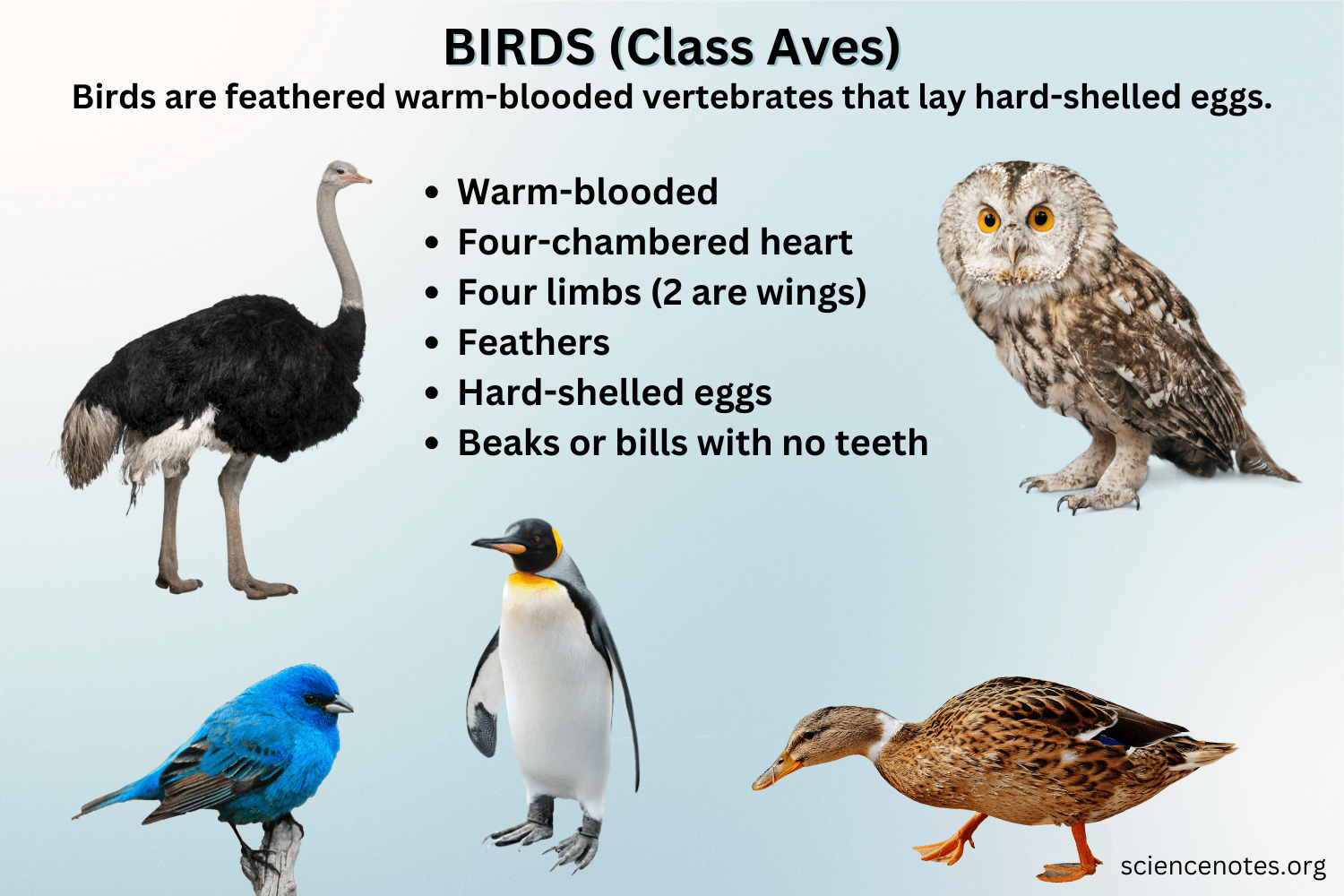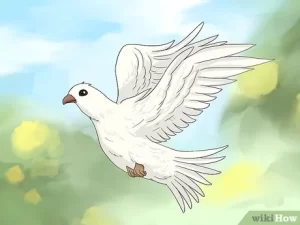
Classification of Birds
Taxonomy
Birds are classified into various taxonomic ranks, with the primary classification being as follows:
- Class: Aves
- Superorders:
- Palaeognathae (includes flightless birds like ostriches)
- Neognathae (includes most modern birds)
Orders of Birds
Birds are further divided into numerous orders, each containing various families and species. Below is a list of some major bird orders:
| Order | Common Examples |
|---|---|
| Struthioniformes | Ostriches |
| Anseriformes | Ducks, Geese |
| Accipitriformes | Eagles, Hawks |
| Galliformes | Chickens, Turkeys |
| Passeriformes | Sparrows, Finches |
| Psittaciformes | Parrots, Macaws |
| Columbiformes | Pigeons, Doves |
| Piciformes | Woodpeckers |
This classification reflects both evolutionary relationships and morphological characteristics.
Characteristics of Birds
Birds possess several distinctive features:
- Feathers: Unique to birds, feathers provide insulation, waterproofing, and aid in flight.
- Beaks: Birds have toothless beaks adapted to their feeding habits.
- Reproductive Traits: Birds lay eggs with hard shells, which are incubated until hatching.
- Physiology: Birds are warm-blooded with a four-chambered heart, which supports their high metabolic rates necessary for flight.
Evolutionary Background
Birds evolved from theropod dinosaurs during the late Jurassic period. The first known bird, Archaeopteryx, exhibits both avian and reptilian features, providing critical insight into the transition from dinosaurs to modern birds.
Behavioral Aspects
Bird behavior is diverse, including:
- Migration: Many species migrate seasonally to exploit food resources and breeding grounds.
- Communication: Birds use vocalizations and body language to communicate with each other, often in complex social structures.
- Nesting: Birds exhibit various nesting behaviors, from elaborate structures to simple ground nests.
Importance of Birds
Birds play crucial roles in ecosystems as pollinators, seed dispersers, and indicators of environmental health. They are also significant in human culture, contributing to art, mythology, and recreation, such as birdwatching.
Conservation Status
Many bird species face threats from habitat loss, climate change, and hunting. Conservation efforts are critical to protect endangered species and maintain biodiversity.
Detailed Classification of Birds
Superorders and Orders
Birds are divided into two superorders: Palaeognathae and Neognathae. Each superorder contains several orders, which are further subdivided into families and species. Below is a more detailed look at some of these orders.
Palaeognathae
Palaeognathae includes flightless birds and those with a primitive palate structure. Key orders include:
- Struthioniformes:
- Examples: Ostriches, Emus, Rheas
- Characteristics: Large, flightless birds with long legs and necks, adapted for running.
- Ptesiiformes:
- Examples: Kiwi
- Characteristics: Small, nocturnal birds with a keen sense of smell and long beaks.
Neognathae
Neognathae encompasses the vast majority of bird species, including both flying and flightless birds. Key orders include:
- Anseriformes:
- Examples: Ducks, Swans, Geese
- Characteristics: Waterfowl with webbed feet and flattened bills, adapted for aquatic life.
- Accipitriformes:
- Examples: Eagles, Hawks, Vultures
- Characteristics: Birds of prey with keen eyesight and strong talons for hunting.
- Galliformes:
- Examples: Chickens, Turkeys, Quails
- Characteristics: Ground-dwelling birds with stout bodies and strong legs, often domesticated.
- Passeriformes:
- Examples: Sparrows, Robins, Crows
- Characteristics: The largest order of birds, known as perching birds, with a wide variety of vocalizations.
- Psittaciformes:
- Examples: Parrots, Cockatoos
- Characteristics: Known for their intelligence and ability to mimic sounds, with strong, curved beaks.
- Columbiformes:
- Examples: Pigeons, Doves
- Characteristics: Generally small to medium-sized birds with a characteristic cooing sound.
- Piciformes:
- Examples: Woodpeckers, Toucans
- Characteristics: Known for their strong bills and unique feeding habits, often drilling into wood.
Morphological Adaptations
Birds exhibit a variety of morphological adaptations that enhance their survival and reproductive success:
- Beak Shapes: The shape of a bird’s beak is closely related to its diet. For example, finches have strong, conical beaks for cracking seeds, while hummingbirds have long, slender beaks for sipping nectar.
- Wing Structure: Wing shapes vary among species, affecting their flight capabilities. For instance, long, narrow wings are typical of birds that soar, while shorter, rounded wings are found in birds that maneuver through dense vegetation.
- Feet and Claws: Birds have evolved various foot structures suited to their lifestyles. Raptors have sharp talons for catching prey, while wading birds have long legs for hunting in shallow water.
Behavioral Ecology
Social Structures
Birds exhibit a wide range of social behaviors, from solitary to highly social species. Some key social structures include:
- Monogamous Pair Bonds: Many bird species form monogamous pairs for breeding, working together to raise their young.
- Flocks: Some species, such as starlings and finches, form flocks for foraging and protection from predators. Flocking behavior can enhance foraging efficiency and reduce individual predation risk.
- Territoriality: Many birds establish and defend territories to secure resources such as food and nesting sites. Males often engage in vocal displays or physical confrontations to establish dominance.
Communication
Birds communicate through a variety of vocalizations, body language, and visual displays:
- Songs and Calls: Birds use songs for mating displays and territorial defense, while calls are often used for communication among flock members.
- Body Language: Displays such as puffing up feathers, bowing, or wing-flapping can convey information about a bird’s intentions or emotional state.
- Visual Signals: Bright plumage and elaborate courtship displays are often used to attract mates or deter rivals.
FAQ Section
What are the main characteristics that define birds?
Birds are characterized by feathers, beaks, the ability to lay hard-shelled eggs, and a high metabolic rate supported by a four-chambered heart.
How are birds classified scientifically?
Birds are classified under the class Aves, which is divided into superorders and numerous orders based on evolutionary relationships and morphological traits.
Why are birds considered reptiles?
In modern taxonomy, birds are classified as reptiles due to their evolutionary lineage, sharing a common ancestor with theropod dinosaurs.
What roles do birds play in ecosystems?
Birds contribute to ecosystems by pollinating plants, dispersing seeds, controlling insect populations, and serving as indicators of environmental health.
How can we help in bird conservation?
Individuals can support bird conservation by participating in habitat restoration, supporting conservation organizations, and practicing responsible birdwatching.For more detailed information, you can visit the Wikipedia page on Birds.


